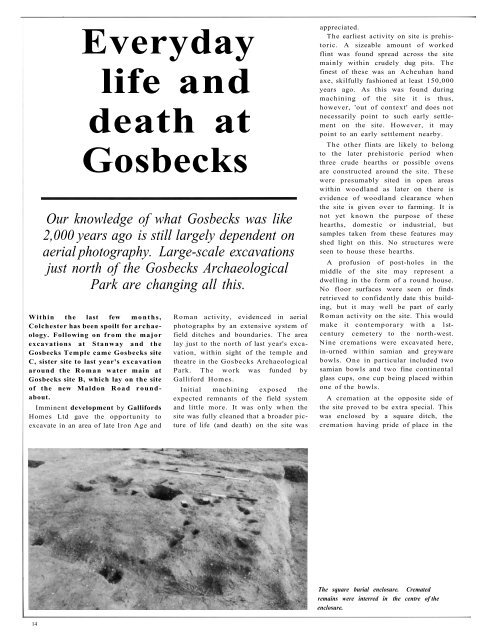The Colchester Archaeologist 1996-7 - Colchester Archaeological ...
The Colchester Archaeologist 1996-7 - Colchester Archaeological ...
The Colchester Archaeologist 1996-7 - Colchester Archaeological ...
You also want an ePaper? Increase the reach of your titles
YUMPU automatically turns print PDFs into web optimized ePapers that Google loves.
Everydaylife anddeath atGosbecksOur knowledge of what Gosbecks was like2,000 years ago is still largely dependent onaerial photography. Large-scale excavationsjust north of the Gosbecks <strong>Archaeological</strong>Park are changing all this.Within the last few months,<strong>Colchester</strong> has been spoilt for archaeology.Following on from the majorexcavations at Stanway and theGosbecks Temple came Gosbecks siteC, sister site to last year's excavationaround the Roman water main atGosbecks site B, which lay on the siteof the new Maldon Road roundabout.Imminent development by GallifordsHomes Ltd gave the opportunity toexcavate in an area of late Iron Age andRoman activity, evidenced in aerialphotographs by an extensive system offield ditches and boundaries. <strong>The</strong> arealay just to the north of last year's excavation,within sight of the temple andtheatre in the Gosbecks <strong>Archaeological</strong>Park. <strong>The</strong> work was funded byGalliford Homes.Initial machining exposed theexpected remnants of the field systemand little more. It was only when thesite was fully cleaned that a broader pictureof life (and death) on the site wasappreciated.<strong>The</strong> earliest activity on site is prehistoric.A sizeable amount of workedflint was found spread across the sitemainly within crudely dug pits. <strong>The</strong>finest of these was an Acheuhan handaxe, skilfully fashioned at least 150,000years ago. As this was found duringmachining of the site it is thus,however, 'out of context' and does notnecessarily point to such early settlementon the site. However, it maypoint to an early settlement nearby.<strong>The</strong> other flints are likely to belongto the later prehistoric period whenthree crude hearths or possible ovensare constructed around the site. <strong>The</strong>sewere presumably sited in open areaswithin woodland as later on there isevidence of woodland clearance whenthe site is given over to farming. It isnot yet known the purpose of thesehearths, domestic or industrial, butsamples taken from these features mayshed light on this. No structures wereseen to house these hearths.A profusion of post-holes in themiddle of the site may represent adwelling in the form of a round house.No floor surfaces were seen or findsretrieved to confidently date this building,but it may well be part of earlyRoman activity on the site. This wouldmake it contemporary with a 1stcenturycemetery to the north-west.Nine cremations were excavated here,in-urned within samian and greywarebowls. One in particular included twosamian bowls and two fine continentalglass cups, one cup being placed withinone of the bowls.A cremation at the opposite side ofthe site proved to be extra special. Thiswas enclosed by a square ditch, thecremation having pride of place in the<strong>The</strong> square burial enclosure. Crematedremains were interred in the centre of theenclosure.14
















